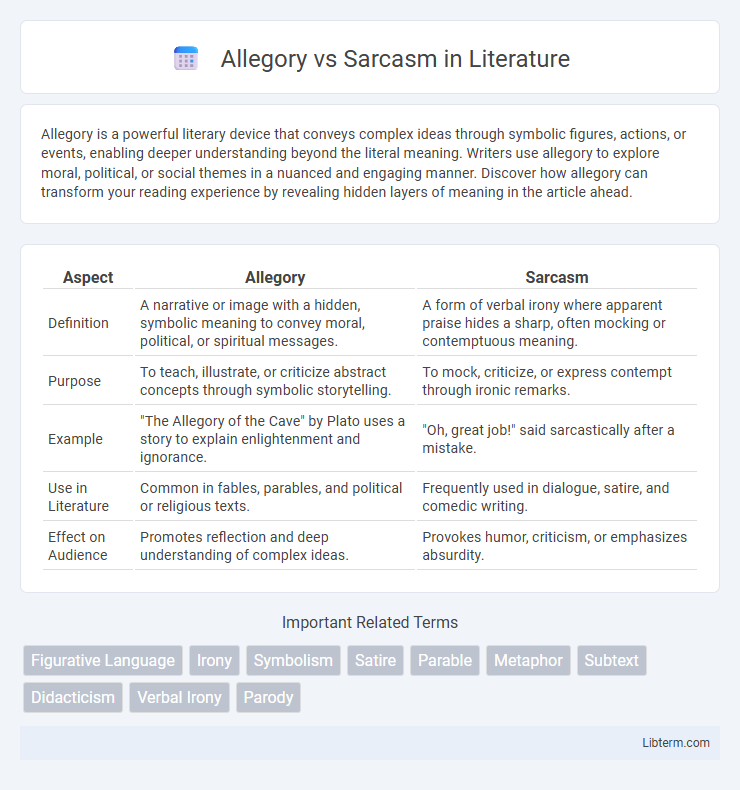Allegory is a powerful literary device that conveys complex ideas through symbolic figures, actions, or events, enabling deeper understanding beyond the literal meaning. Writers use allegory to explore moral, political, or social themes in a nuanced and engaging manner. Discover how allegory can transform your reading experience by revealing hidden layers of meaning in the article ahead.
Table of Comparison
| Aspect | Allegory | Sarcasm |
|---|---|---|
| Definition | A narrative or image with a hidden, symbolic meaning to convey moral, political, or spiritual messages. | A form of verbal irony where apparent praise hides a sharp, often mocking or contemptuous meaning. |
| Purpose | To teach, illustrate, or criticize abstract concepts through symbolic storytelling. | To mock, criticize, or express contempt through ironic remarks. |
| Example | "The Allegory of the Cave" by Plato uses a story to explain enlightenment and ignorance. | "Oh, great job!" said sarcastically after a mistake. |
| Use in Literature | Common in fables, parables, and political or religious texts. | Frequently used in dialogue, satire, and comedic writing. |
| Effect on Audience | Promotes reflection and deep understanding of complex ideas. | Provokes humor, criticism, or emphasizes absurdity. |
Introduction to Allegory and Sarcasm
Allegory conveys deeper meanings through symbolic figures, actions, or imagery, often revealing moral, political, or spiritual lessons beyond the literal narrative. Sarcasm relies on sharp, often ironic remarks to mock or convey contempt, using tone and context to express meaning opposite to the literal words. Both literary devices enhance communication by engaging readers through layered interpretation or biting wit.
Defining Allegory: Beyond Literal Meaning
Allegory conveys deeper meanings through symbolic figures, actions, or imagery, transcending the literal narrative to reveal moral, social, or political messages. It operates on multiple levels, inviting interpretation beyond the surface story, often embodying abstract concepts or universal truths within concrete characters or events. Unlike sarcasm, allegory sustains an extended metaphorical framework rather than relying on sharp or ironic remarks to convey its message.
Understanding Sarcasm: The Art of Verbal Irony
Sarcasm is a form of verbal irony where the intended meaning is opposite to the literal expression, often used to convey contempt or humor. It relies heavily on tone, context, and social cues to signal the speaker's true intent, distinguishing it from straightforward statements. Mastering sarcasm requires recognizing subtle linguistic markers and cultural nuances that reveal the speaker's underlying attitude.
Key Differences Between Allegory and Sarcasm
Allegory conveys deeper meanings through symbolic storytelling, often reflecting moral, political, or spiritual messages, while sarcasm uses sharp, often ironic remarks to mock or convey contempt. Allegory unfolds through extended narratives or images representing abstract ideas, whereas sarcasm typically appears in concise, spoken or written expressions with an intention to criticize or amuse. Understanding these distinctions enhances comprehension of literary devices and their impact on communication styles.
Historical Origins and Evolution
Allegory traces its origins to ancient civilizations such as Mesopotamia and Egypt, where symbolic storytelling conveyed moral and spiritual lessons, evolving through classical literature by authors like Plato and Dante. Sarcasm, rooted in ancient Greek rhetoric, was initially used by playwrights like Aristophanes to deliver biting social criticism through ironic and satirical remarks. Over centuries, allegory developed into complex literary and artistic forms, while sarcasm became a sharp linguistic tool for humor and critique in everyday speech and literature.
Common Uses in Literature and Media
Allegory is frequently used in literature and media to convey complex moral, political, or spiritual messages through symbolic characters and narratives, as seen in works like George Orwell's *Animal Farm* which critiques totalitarian regimes. Sarcasm often appears in dialogue and satire to express contempt or mock, adding humor or criticism, prevalent in television shows like *The Simpsons* and novels by authors such as Mark Twain. Both devices enhance thematic depth, with allegory providing layered meaning and sarcasm delivering sharp social commentary.
Recognizing Allegory in Famous Works
Recognizing allegory in famous works involves identifying symbolic narratives where characters, events, or settings represent broader moral, political, or social meanings, as seen in George Orwell's *Animal Farm*, which critiques totalitarianism through a farm animal rebellion. Classic examples like John Bunyan's *The Pilgrim's Progress* use allegory to depict the spiritual journey, with each character embodying particular virtues or vices. Understanding allegory requires analyzing underlying themes beyond the literal story, revealing deeper insights into the author's message or critique.
Spotting Sarcasm in Everyday Language
Spotting sarcasm in everyday language relies heavily on tone, context, and non-verbal cues such as facial expressions and body language. Sarcasm often features exaggerated intonation or stark contrast between literal meaning and intended message, signaling irony or mockery. Recognizing these linguistic and paralinguistic markers enhances accurate interpretation and avoids misunderstanding.
Impact on Audience Interpretation
Allegory engages the audience by conveying deeper meanings through symbolic narratives, prompting reflective interpretation and revealing layered messages over time. Sarcasm immediately impacts the audience with sharp, often ironic remarks that challenge or mock viewpoints, triggering quick emotional responses. The contrasting effects shape how audiences perceive underlying intentions, with allegory fostering contemplation and sarcasm inciting immediate judgment or skepticism.
Choosing Between Allegory and Sarcasm in Writing
Choosing between allegory and sarcasm in writing depends on the intended depth and tone of the message. Allegory offers a layered, symbolic approach that conveys complex ideas through extended metaphor, ideal for exploring moral, political, or philosophical themes. Sarcasm delivers sharp, often humorous critique through irony and exaggeration, making it effective for direct, punchy commentary or social satire.
Allegory Infographic

 libterm.com
libterm.com